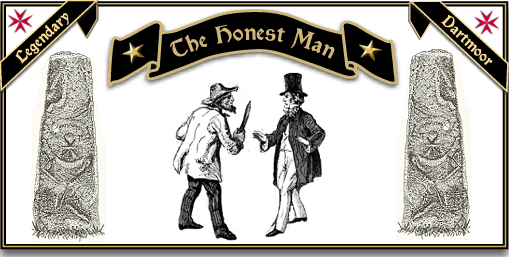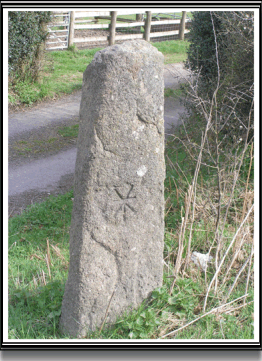
This stone stands beside the road at the top of Bude Lane. Originally it stood on the wayside of The Mariners Way which was an old track which took sailors from Dartmouth to Bideford. According to legend one of these old seadogs had stopped off at the Sticklepath Inn to splice the mainbrace and not only spliced it he well and truly severed it. So found himself lost in a thick mist of ale up on Sticklepath Hill. In desperation he groped around in the dark to try and find a signpost or somebody who could set him on his way. Eventually he espied a figure looming out of the night and lurched forward to embrace the figure. Sadly this turned out to be an old menhir (standing stone) but he never knew the difference and so asked of the figure “be you an honest man” – thus naming the stone.
Another more plausible version is that a traveller on the same road was set upon by a gang of thieves who robbed him of all his worldly possessions. Luckily a passer-by saw the mugging and went to the poor mans assistance. After a struggle the thieves were driven off and the traveller had his money etc returned. Overcome by gratitude the wayfarer found the old menhir and had it re-erected in the spot of the robbery as a memorial to the bravery of ‘The Honest Man’.

The Honest Man
This stone now stands on the parish bounds of Belstone and Sticklepath. and is one of the points observed when beating the bounds. It is noted during the 2000 bound ceremony that “Between Tongue End and the start of the track to Bude Farm, the boundary between Belstone and Sticklepath parishes switches to the north side of the road. The ancient Honest Man stone … marks this junction”. In 1990 a near miss by a car resulted in the National Park Authority digging a ditch around the stone, this revealed more of the original three feet previously exposed and exposed nearly another three feet. In 1991 it was re-erected on a firmer base. On the northern face of the stone there is a small circle inscribed near the top, with another larger circle below it. Below these a St. Andrew’s Cross can be see with yet the largest engraved circle under that. Originally from halfway down the cross the rest of the stone was buried. The south side of the stone sports a cancelled Ordnance Surveyors bench mark under which can be seen a small arc. Below this again there are two half circles. The eastern face bears a short arc above a small circle with another device below that, Brewer, 2002, pp186-7. The drawing above shows the southern face of the stone with the bench mark central. Today’s measurements are 1.27m in height and a circumference of 98.5cm, Sandles, 1997, p.98. There are two other early incised stones nearby, one at Sticklepath by the Lady Well and one on the village green at Sourton. St. Ledger-Gordon, 1972, p.76, considers that the ‘Honest Man’ is an old Bronze Age ‘menhir‘ or standing stone that was later used as a signpost or marker for a place of pagan worship. She also states two of the symbols represent a sun disc and a crescent moon, with the St. Andrew’s cross being added at a later date to Christianise the stone. The nearest church dedication to St. Andrew is the church at South Tawton which is about 2 miles away but the date of the earliest church here is of the 12th century. It is difficult to pin a date on this stone as everybody seems reluctant to do so, but there are a couple off tentative suggestions that this stone is Saxon. Certainly during the Saxon period there is evidence of early Christian activity with the founding of the abbeys at Tavistock and Buckfastleigh and a small number of churches that have Celtic dedications, the nearest being St. Petroc’s church which is 12 miles away. “All of the inscribed stones in the area lie at the interface between the moorland and enclosed land and are sited on routeways”, Gerrard, 1997 pp. 69-70. Writing in 1869, Page, 1895, pp.84-5, describes the incised markings very much as they appear today except on the southern face he describes as seeing a resemblance to a human face surrounded by a halo and that it was also possible to see arms and legs. He also surmises that the addition of the St. Andrew’s cross could indicate that the stone was dedicated to him. The normally accepted derivation of the word ‘menhir’ comes from the Celtic maen (stone) and hir (long) giving you ‘longstone’. Standing at 1.27m, I would suggest that this stone would only loosely fall into that category. But the use of the word man may indicate relate to the Celtic maen suggesting an early stone. Moralistically the purpose of the second story points to the ‘good Samaritan’ theory and helping travellers in distress. The first story sounds very much like a story told on a winter’s night sat in front of a peat fire in a local pub. It is interesting to note that when writing in the 1800’s Page did not mention the actual name ‘Honest Man’. He goes into a lengthy description of it so surely if the name was in use then he would have referred to it. This suggests that the name came into use after that period thus making the stories fairly modern.
The Honest Man is a good example of a pagan relic that has been ‘cleansed’ by the addition of a Christian symbol.

Brewer, D. 2002, Dartmoor Boundary Markers, Halsgrove, Tiverton.
Gerrard, S. 1991, Dartmoor, Batsford, London.
Page, J. Ll. W. 1895 The Exploration of Dartmoor, Seeley & Co. London
St. Ledger-Gordon, 1972, The Witchcraft and Folklore of Dartmoor, EP Publishing, Wakefield.
Sandles, T. 1997, A Pilgrimage to Dartmoor Crosses, Forest Publishing, Liverton.
 Legendary Dartmoor The many aspects past and present of Dartmoor
Legendary Dartmoor The many aspects past and present of Dartmoor

One comment
Pingback: #OnePlaceLandmarks: Menhirs #SticklepathOne ‘s Standing Stones, our granite pillars. – Sticklepath a Village and its People